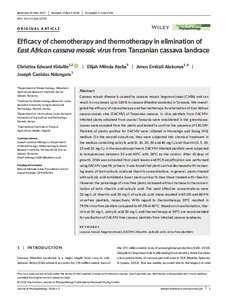| dc.contributor.author | Kidulile, C.E. |
| dc.contributor.author | Ateka, E.M. |
| dc.contributor.author | Alakonya, A. |
| dc.contributor.author | Ndunguru, J.C. |
| dc.date.accessioned | 2019-12-04T11:24:28Z |
| dc.date.available | 2019-12-04T11:24:28Z |
| dc.date.issued | 2018-08-12 |
| dc.identifier.citation | Kidulile, C.E., Miinda Ateka, E., Alakonya, A.E., & Ndunguru, J.C. (2018). Efficacy of chemotherapy and thermotherapy in elimination of east African cassava mosaic virus from Tanzanian cassava landrace. Journal of Phytopathology, 1-7. |
| dc.identifier.issn | 0931-1785 |
| dc.identifier.uri | https://hdl.handle.net/20.500.12478/4377 |
| dc.description.abstract | Cassava mosaic disease is caused by cassava mosaic begomoviruses (CMBs) and can result in crop losses up to 100% in cassava (Manihot esculenta) in Tanzania. We investigated the efficacy of chemotherapy and thermotherapy for elimination of East African cassava mosaic virus (EACMV) of Tanzanian cassava. In vitro plantlets from EACMV‐infected plants obtained from coastal Tanzania were established in the greenhouse. Leaves were sampled from the plants and tested to confirm the presence of EACMV. Plantlets of plants positive for EACMV were initiated in Murashige and Skoog (MS) medium. On the second subculture, they were subjected into chemical treatment in the medium containing salicylic acid (0, 10, 20, 30 and 40 mg/L) and ribavirin (0, 5, 10, 15 and 20 mg/L). In the second experiment, EACMV‐infected plantlets were subjected to temperatures between 35 and 40°C with 28°C as the control. After 42 days of growth, DNA was extracted from plant leaves and PCR amplification was performed using EACMV specific primers. It was found that plant survival decreased with increasing levels of both salicylic acid and ribavirin concentrations. In general, plants treated with salicylic acid exhibited a lower plant survival % than those treated with ribavirin. However, the percentage of virus‐free plants increased with an increase in the concentration of both ribavirin and salicylic acid. The most effective concentrations were 20 mg/L of ribavirin and 30 mg/L of salicylic acid; these resulted in 85.0% and 88.9% virus‐free plantlets, respectively. With regard to thermotherapy, 35°C resulted in 79.5% virus‐free plantlets compared to 69.5% at 40°C. Based on virus elimination, ribavirin at 20 mg/L, salicylic acid 30 mg/L and thermotherapy at 35°C are recommended for production of EACMV free cassava plantlets from infected cassava landraces. |
| dc.description.sponsorship | Bill & Melinda Gates Foundation |
| dc.format.extent | 1-7 |
| dc.language.iso | en |
| dc.subject | African Cassava Mosaic Virus |
| dc.subject | Begomovirus |
| dc.subject | Ribavirin |
| dc.subject | Salicylic Acids |
| dc.subject | Virus-Free Plants |
| dc.title | Efficacy of chemotherapy and thermotherapy in elimination of east African cassava mosaic virus from Tanzanian cassava landrace |
| dc.type | Journal Article |
| dc.description.version | Peer Review |
| cg.contributor.crp | Roots, Tubers and Bananas |
| cg.contributor.affiliation | Mikocheni Agricultural Research Institute, Tanzania |
| cg.contributor.affiliation | Jomo Kenyatta University of Agriculture and Technology |
| cg.contributor.affiliation | International Institute of Tropical Agriculture |
| cg.coverage.region | Africa |
| cg.coverage.region | East Africa |
| cg.coverage.country | Tanzania |
| cg.creator.identifier | amos Alakonya: 0000-0001-7710-499X |
| cg.researchtheme | PLANT PRODUCTION & HEALTH |
| cg.isijournal | ISI Journal |
| cg.authorship.types | CGIAR and developing country institute |
| cg.iitasubject | Plant Health |
| cg.iitasubject | Plant Production |
| cg.journal | Journal of Plant Pathology |
| cg.howpublished | Formally Published |
| cg.accessibilitystatus | Open Access |
| local.dspaceid | 100529 |
| cg.targetaudience | Scientists |
| cg.identifier.doi | https://dx.doi.org/10.1111/jph.12725 |

